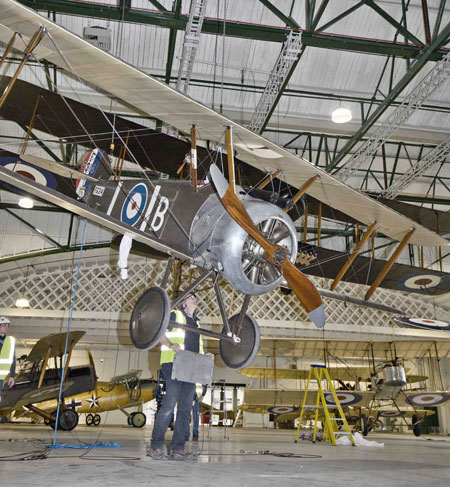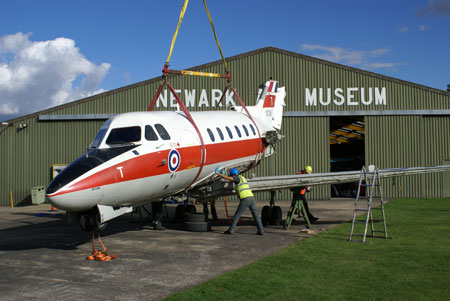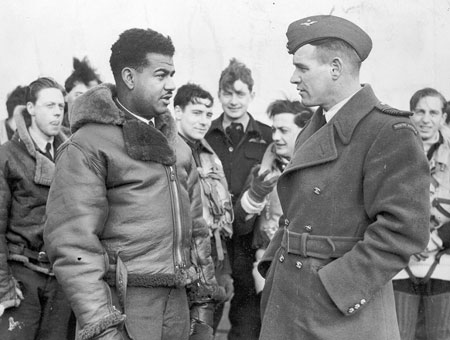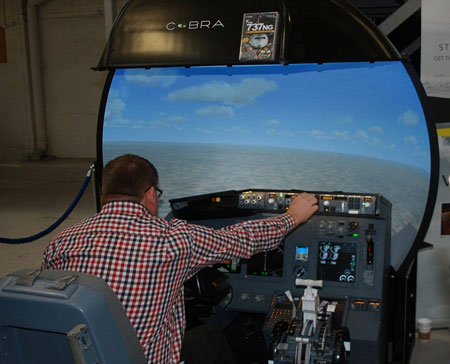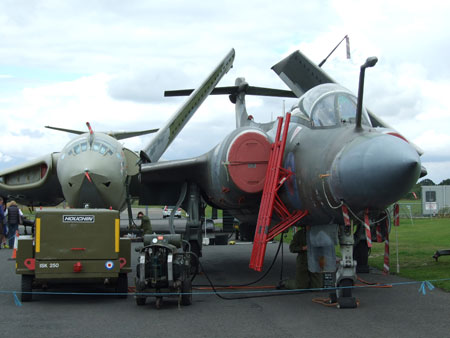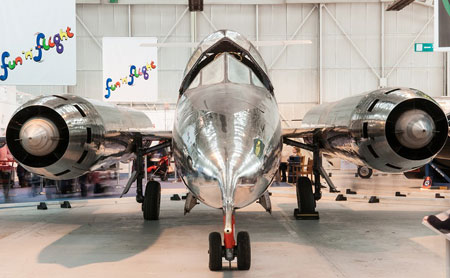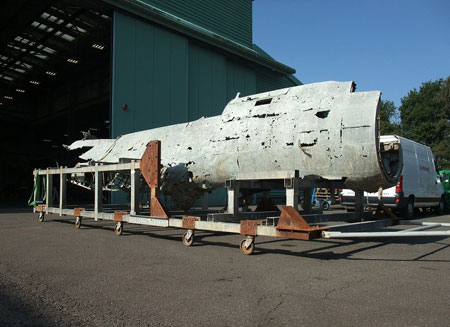
The world’s last surviving Dornier Do 17 has now moved into the second phase of its conservation at the Royal Air Force Museum Cosford.
It’s been a little over 15 months since the aircraft was lifted from the bottom of the Dover Straits and transported to the Museum’s Cosford site for ground breaking conservation work. The process so far has seen the aircraft systematically sprayed with a low concentration citric acid based solution inside purpose built hydration tunnels. This process has helped to remove marine accretions and subsequently the neutralised corrosion impurities in the aluminium aircraft structure.
The project is progressing at a much faster rate than previously anticipated and the Museum is delighted to see second stage conservation work commence on the aircraft’s forward fuselage. Confident that the citric acid solution has done its job, the fuselage was removed from the tunnels early September and has undergone an intense wash down, before being moved into the Conservation Centre.
Aircraft Technician Andy Woods is now working on the Dornier full time, with his initial efforts focused on internal cleaning and removing any remaining marine deposits with the use of plastic scrapers. Control rods and other smaller items are being carefully removed allowing Technicians greater access to the airframe structure beneath. A team of Volunteers will work on the components removed from the aircraft and which will be put back at a later date.
The construction of the wings has made the process of removing salt and sand from internal sections much slower than the fuselage. The wing section has recently been subject to a deep clean by a team of Apprentices and over a tonne of salt and sand has been removed from the aircraft. Further time in the hydration tunnels is required to allow the citric acid to do its work before the wings join the fuselage in the Conservation Centre.
Both engines and propellers have been removed from the tunnels and mounted on purpose built stands allowing easier access for Technicians to begin treatment. During the aircrafts time underwater the magnesium components disintegrated but the steel components remained fully intact. The majority of the marine deposits have now been removed and a test section has been coated in a 2-pac polly acrylic mix. The Conservation team at Cosford are confident that leaving some of the internal marine deposit on the airframe will provide strength to the fragile aluminium skins.
The Imperial College London continues to offer guidance and over the Summer, Scientist Yanika Agius spent three weeks working with the Museum. Sample testing was carried out on sections of the aircraft to monitor if the spraying process had removed all the crystallised salts from the metalwork. The results showed that most areas were clear with just a few sections of the tail plane needing further attention. Treatment will now see pieces of felt soaked in the citric acid solution and placed on the areas with crystals remaining, concentrating the solution to where it’s needed. Testing will be carried out in a few weeks’ time to see if the remaining crystals have been removed.
The gradual process of removing the thick layer of marine deposits has revealed several bullet holes and shrapnel damage on the airframe, plus small areas of the original paint finish. While working on some of the smaller components, Volunteers discovered push rods still coated in their original oil and when a pipe was removed from a fuel injection unit, a small amount of the original fuel was still present. An interesting discovery during the Summer was the flare pistol still mounted in its original stowage within the forward fuselage. Having informed and called in the appropriate authorities, the pistol was declared safe and Technicians subsequently removed it from the aircraft. Volunteers have since carried out conservation work on the flare pistol which is now on display at the Museum.
Darren Priday, Conservation Centre Manager at RAF Museum Cosford says:
“The citric acid solution has worked wonders on the large and small objects inside the hydration tunnels. It was a major milestone when the forward fuselage was removed from the treatment area and gave us the first indication that there was light at the end of the tunnel. We are not taking things for granted and we are keeping a careful eye on the section as she is quite fragile, but then anything would be after spending 73 years in the hostile Dover Straits.
Having Yanika from the Imperial College was a major boost for us as she was able to carry out tests for salt crystals, something that is not visible with the naked eye. The Cosford volunteers are continuing to carry out the small item conservation and will be available for those attending the Conservation Centre Open Week to learn more.”
At the time of the Dornier’s recovery, it was unclear just how much of the aircraft could be saved following over seventy years on the seabed. Visitors to the Museum are invited to attend the Conservation Centre Open Week in November and see for themselves the fantastic progress being made on the aircraft, only a year and a half since it was raised from the Dover Straits.
The Open Week will run from 9-15 November from 10:15am until 1:00pm each day. Visitors can get up close to the aircraft and speak with the team of Technicians, Apprentices and Volunteers working on the Dornier project as well as other aircraft currently being restored. Admission to the Conservation Centre Open Week is £5 per person with all proceeds going towards the maintenance and upkeep of the exhibits. Children under 16 accompanied by an adult are free.
Admission to the Museum is FREE of charge. Anyone wishing to donate towards the conservation of the aircraft can do so online via the Museum website www.rafmuseum.org. For more information please call the Museum on 01902 376200.
